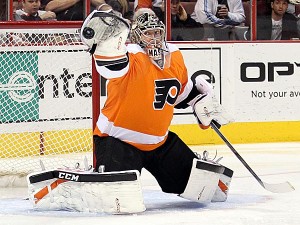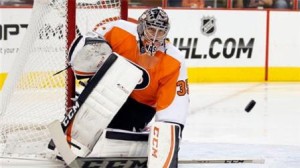With the newly implemented playoff system, this year’s playoff matchups came into focus a bit quicker than they have in recent seasons. I remember the past few years writing multiple scouting posts depending on how the Rangers ultimately finished in the standings. This year, however, it’s only down to Philly and Columbus as potential opponents. I’m going to lead off with Steve Mason, and if Columbus jumps the Flyers in the standings, I’ll just hijack one of my colleague’s slots next week to scout Bobrovsky. Coin flip at this point.
The format remains the same, Stance, Crease Movement/Depth, Equipment, Puck-handling ability and Exploitable Weaknesses. Let’s get after it…
At this point, most of us know the book on Mason: Rookie of the Year winner, future superstar turned reclamation project for the Flyers. No one really knows that happened to him after that first season in Columbus that wrecked his confidence, but he has rebounded significantly in his first season in Orange and Black, and was rewarded with a slightly pre-mature, slightly ridiculous 3-year/$12.3 million contract.
Stance
From a visual standpoint, Mason is something like a southpaw Carey Price. Now, this isn’t to say at all that he is even in the same stratosphere talent-wise as the Habs’ keeper, but the style is very similar.
The design is to sit comfortably in your hip-flexors without coiling up your crouch too much. It allows for fluid and balanced movement, but sacrifices explosiveness. And therein lies the biggest difference between Mason and Price is that core strength. Price effortless glides around the crease with precision and grace, and it’s more of a chore for Mason.
This doesn’t render his style ineffective, it just doesn’t translate to that elite performance that everyone was hoping for during his impressive rookie campaign. Aside from the balance, his stance is pretty average. Not many quirks, average leg width, gloves high, the usual. The most interesting thing about it is that he catches with the wrong hand…
Crease Movement/Depth
As mentioned in the previous section, Mason does not have elite mobility. He moves around well, utilizing butterfly slides and good positional instincts. His depth is a little deeper than average; you don’t see him getting caught too far from home, but isn’t a goal line keeper like Hank is either. He is generally found just below the top of the crease for normal movements.
As many goalies are starting to incorporate more, Mason is a sucker for the paddle-down technique. It helps seal up the bottom part of the net with no gaps (like between the pads), but it forces the goalie to drop the blocker shoulder to position the stick flush. This creates vulnerability high if not executed properly. Just something to keep an eye on.
Equipment
Over the years, Mason has been a complete and utter gear-whore. He has had countless sets of equipment to match the wide array of Blue Jackets uniforms over the years and has been known to switch pads multiple times through out the season. He’s not quite on Tim Thomas’ level, but not far off.
Mason has historically been a Vaughn guy, wearing the traditional Velocity line before switching to the more hybrid 7900 series. In his last year in Columbus, he made the manufacturer shift to the CCM EFP line, which he’s been wearing ever since. The construction of the pads seem very similar to the Vaughn’s visually, but in reality are much, much stiffer.
I would be remiss if I didn’t mention an observation of Mason’s equipment prior to his rebound season this year. It always seemed that his equipment didn’t fit properly with the Blue Jackets. The thigh rise on the pads were always very short, and he didn’t wear proportional body padding. I know people are always at the size of goalie equipment, but he kind of looked like a Praying Mantis out there. His current set up is much more appropriate.
Puck-Handling
Mason is a very competent puck-handling goalie. He’s not flashy like Brodeur or Smith, but he knows what he’s doing. He utilizes the overhand grip that was pioneered by Marty Turco in the late 90’s to solid effect. I wouldn’t worry so much about him launching the homerun passes, but he’s not easily rattled behind the cage and won’t be giving away many careless mistakes.
Exploitable weaknesses
Mason’s achilles heel has always been the squeaker. He’s been prone to being in solid position, but just lets the puck squeeze through his arm or between the legs (we saw this the last time the two teams met). He has remedied much of the problem this year, and I think it could also be attributable to the equipment issues in Columbus. However, the Rangers should not hesitate to throw pucks at the net whenever possible, because you honestly just don’t know with Mason. One of them could be a backbreaker.
Aside from just constant peppering, it would behoove the Rangers to try and force Mason to move laterally, but above the net-mouth. He seals the bottom of the net well and has an active stick, so you need to get the puck out of his reach and force him out of position. He has that slight Luongo tendency to end up on his face going side to side when his balance isn’t weighted correctly.
Conclusion
With 15 of the 16 playoff spots locked up, I feel comfortable in saying the Flyers have the worst goaltending amongst playoff teams outside of Minnesota. Mason doesn’t stack up well against any of the Eastern Conference’s top tenders and the Flyers are going to have to score an awful lot of goals to compensate if they play on a making a run.
There is a definite weakness on the back-end to exploit if the Rangers do draw the Flyers, and is probably the best paper matchup the Blueshirts could get. That doesn’t mean it will be easy, but its better than Rask, Howard, Bishop, Bobrovsky or Fleury.
Share:
More About:Analysis




